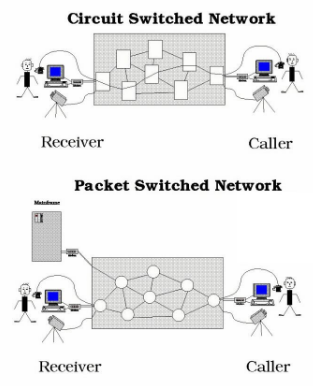Data Communication and Networking – Switching network Study Notes

A switched network consists of a series of interlinked nodes, called switches. Traditionally’ three methods of switching have been important: circuit switching, packet switching, and message switching.
We can divide today’s networks into three broad categories: circuit-switched networks, packet-switched networks, and message-switched. Packet-switched networks can also be divided into two subcategories: virtual-circuit networks and datagram networks
A circuit-switched network is made of a set of switches connected by physical links, in which each link is divided into n channels. Circuit switching takes place at the physical layer. In circuit switching, the resources need to be reserved during the setup phase; the resources remain dedicated for the entire duration of data transfer phase until the teardown phase.
In packet switching, there is no resource allocation for a packet. This means that there is no reserved bandwidth on the links, and there is no scheduled processing time for each packet. Resources are allocated on demand.
In a datagram network, each packet is treated independently of all others. Packets in this approach are referred to as datagrams. There are no setup or teardown phases.
A virtual-circuit network is a cross between a circuit-switched network and a datagram network. It has some characteristics of both.
Circuit switching uses either of two technologies: the space-division switch or the time-division switch.
A switch in a packet-switched network has a different structure from a switch used in a circuit-switched network.We can say that a packet switch has four types of components: input ports, output ports, a routing processor, and switching fabric.